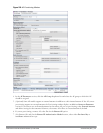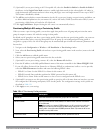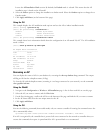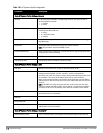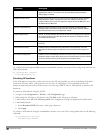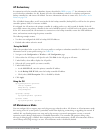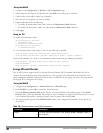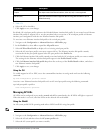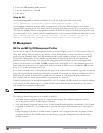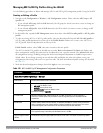
418 | AccessPoints(APs) DellPowerConnectW-SeriesArubaOS6.2 | User Guide
Parameter Description
Basic AP System Profile Settings—General
RF Band For APs that support both 802.11a and 802.11b/g RF bands, specify the RF band in
which the AP should operate:
l g = 2.4 GHz
l a = 5 GHz
RF Band for AM Mode scanning For Air Monitors that support both 802.11a and 802.11b/g RF bands, specify the RF
band which the AM should scan:
l a = 5 GHz
l all = both radio bands
l g = 2.4 GHz
Native VLAN ID Native VLAN for bridge mode virtual APs (frames on the native VLAN are not tagged
with 802.1q tags).
Session ACL Session ACL configured with the ip access-list session command.
NOTE: This parameter requires the PEFNG license.
Corporate DNS Domain Name of domain that is resolved by corporate DNS servers. Use this parameter when
configuring split-tunnel forwarding.
SNMP sysContact SNMP system contact information.
LED operating mode The operating mode for the 802.11n-capable AP LEDs.
Basic AP System Profile Settings—LMS
SAP MTU Maximum Transmission Unit, in bytes, on the wired link for the AP.
LMS IP In multi-controller networks, this parameter specifies the IP address of the local
management switch (LMS)—the Dell controller—which is responsible for
terminating user traffic from the APs, and processing and forwarding the traffic to the
wired network. This can be the IP address of the local or master controller.
When using redundant controllers as the LMS, set this parameter to be the VRRP IP
address to ensure that APs always have an active IP address with which to terminate
sessions.
NOTE: If the LMS-IP is blank, the access point will remain on the controller that it
finds using methods like DNS or DHCP. If an IP address is configured for the LMS IP
parameter, the AP will be immediately redirected to the controller at that address.
Backup LMS IP In multi-controller networks, specifies the IP address of a
backup
to the IP address
specified with the lms-ip parameter.
LMS IPv6
Backup LMS IPv6
LMS Preemption When this parameter is enabled, the AP automatically reverts to the primary LMS IP
address when it becomes available.
Basic AP System Profile Settings—Remote AP
LMS Hold-down Period Time, in seconds, that the primary LMS must be available before an AP returns to
Table 120:
AP System Profile Configuration




